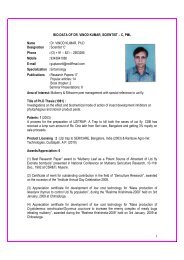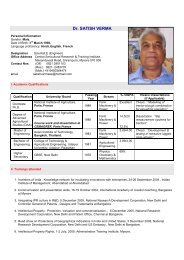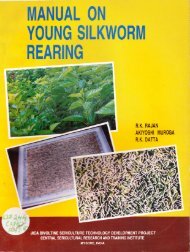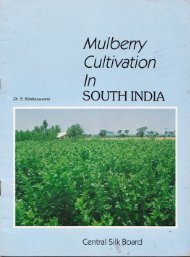Silkworm
A Treatise on the Acid Treatment of Silkworm Eggs - Central ...
A Treatise on the Acid Treatment of Silkworm Eggs - Central ...
Create successful ePaper yourself
Turn your PDF publications into a flip-book with our unique Google optimized e-Paper software.
Selection of the acid<br />
For consistent good results, stronger inorganic acids have been found in general, better lhan organic<br />
acids. Amongst the inorganic acids again, Nitric acid, Sulphuric acid and Aqua regia (a combination of<br />
Nitric acid and Hydrochloric acid in a ratio of 1:3) have been found to be too strong for use and difficult to<br />
handle. Comparative figures with regard lo concentration (percent by weight) and densities of different<br />
inorganic acids are given in Table 2.<br />
TABLE 2<br />
Specilic gravity and concentration of different acids<br />
Name of the acid<br />
Concentration of acid at<br />
saturation (%)<br />
Density at 20"C<br />
Hydrochloric acid (HCl)<br />
Nitric acid (HNO")<br />
Sulphuric acid (H,SO.)<br />
40<br />
100<br />
100<br />
1.1980<br />
1.5129<br />
1.8305<br />
Evidently, Nitric acid and Sulphuric acid are distinctly stronger in nature and pose handling problems.<br />
Thus, in practice, HCI alone is being exploited forthe acid treatment of silkworm eggs both at commercial<br />
and laboratory levels. lt has been found to be the safest and best medium for treating diapausing eggs<br />
to obtain maximum hatching.<br />
Hydrochloric acid is a by-product obtained while manufacturing soda-ash and is subsequently<br />
purif ied to the required levels. Pure HCI is colourless and emanates strong and obnoxious fumes. The<br />
yellow colour of certain commercial HCI products is often caused by iron and other impurities. lt fumes<br />
in moist air and is very easily soluble in water.' lt has strong acid taste with pungent irritating odour and<br />
attacks the mucous membrane upon inhalation.<br />
HCI is marketed as a solulion containing mostly 28 to 36% Hyirogen Chloride by weight and is<br />
commonly known as concentrated HCl. The concentration and specific gravity of HCI are correlated as<br />
indicated in Table 3.<br />
TABLE 3<br />
Relationship between Specific Gravity and Concentration of HCI<br />
Specific gravity of acid at 20"C<br />
1 .198<br />
1.195<br />
1.190<br />
1.180<br />
1.170<br />
1.160<br />
1.150<br />
'1<br />
.1 40<br />
1.130<br />
1.120<br />
1.1 10<br />
1.100<br />
1.095<br />
1.090<br />
1.085<br />
1.080<br />
1.075<br />
1.O70<br />
Concentration of acid (%)<br />
40<br />
39<br />
38<br />
50<br />
34<br />
32<br />
30<br />
28<br />
zo<br />
24<br />
22<br />
20<br />
19<br />
18<br />
17<br />
16<br />
15<br />
14<br />
9




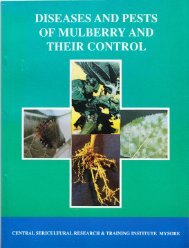

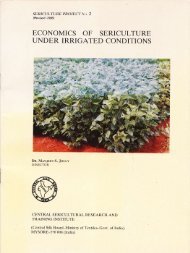
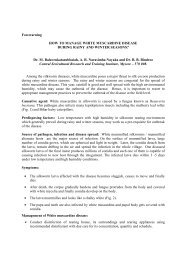
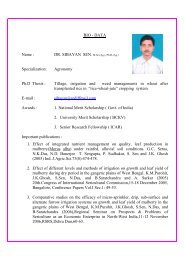
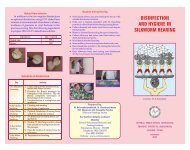
![E}A]\GALORE](https://img.yumpu.com/54052619/1/190x260/eagalore.jpg?quality=85)

